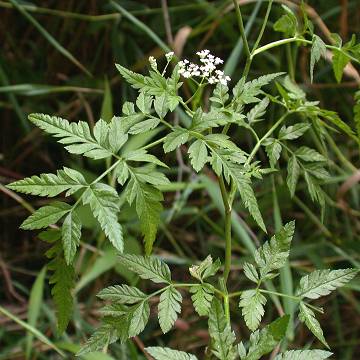

Osmorhiza claytonii - (image 1 of 3)
Taxonomy
Family: Apiaceae
Habitat
Woodlands, often disturbed ones.
Associates
Distribution
Most of the eastern half of the U.S. (except a few southern states) and southeast Canada.
Morphology
Erect, inodorous perennial from thick roots. Leaves ternately compound, the lower petiolate, upper subsessile; leaflets distinct, serrate, 1 cm or more wide. Umbels peduncled, terminal and lateral, surpassing the leaves, rays 2-8; involucral bracts mostly 3-4, less than 1 mm wide; involucel (secondary involucre) present at flowering; flowers never more than 10 per umbellet; petals white; sepals obsolete; mature styles nearly straight and parallel, 1.5 mm. Fruits slightly flattened laterally, narrow and elongate, not winged.
Notes
Flowers early May to mid June.
Wetland indicator: Facultative Upland -
Peterson (1977) calls this plant Sweet Cicely and attributes to it the anise-like scent of O. longistylis. Gleason and Cronquist (1991) state that this plant is inodorous and suggest the name Bland Sweet Cicely. The leaves of O. claytonii tend to be somewhat more hairy above than O. longistylis. Notice that the styles do not exceed the petals.
References
Gleason, Henry A. and A. Cronquist. 1991. Manual of Vascular Plants of Northeastern United States and Adjacent Canada. Second Ed.
The New York Botanical Garden. Bronx, NY
Peterson, L. A. 1977. A Field Guide to Edible Wild Plants: Eastern and central North America.
Houghton Mifflin Company. New York, NY
Swink, F. and G. Wilhelm. 1994. Plants of the Chicago Region.
Indiana Academy of Science. The Morton Arboretum. Lisle, Illinois.
|
Michael Hough © 2005 |